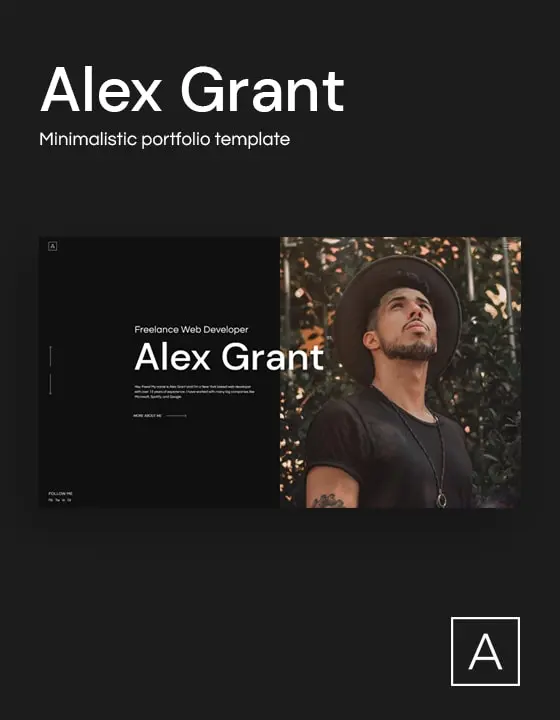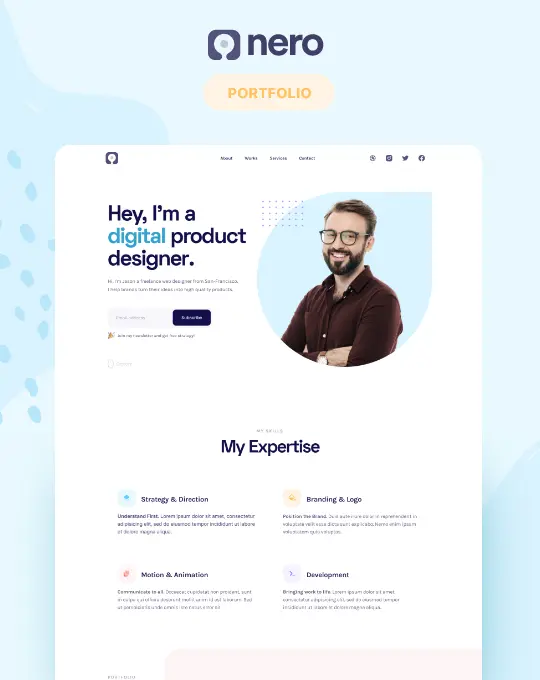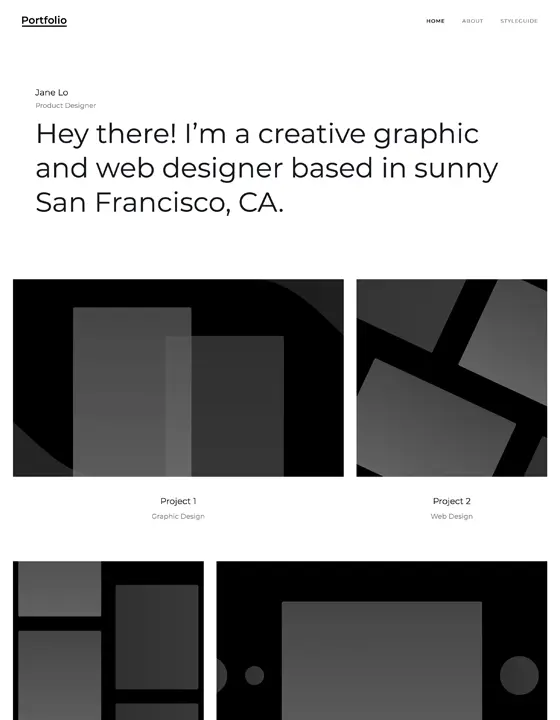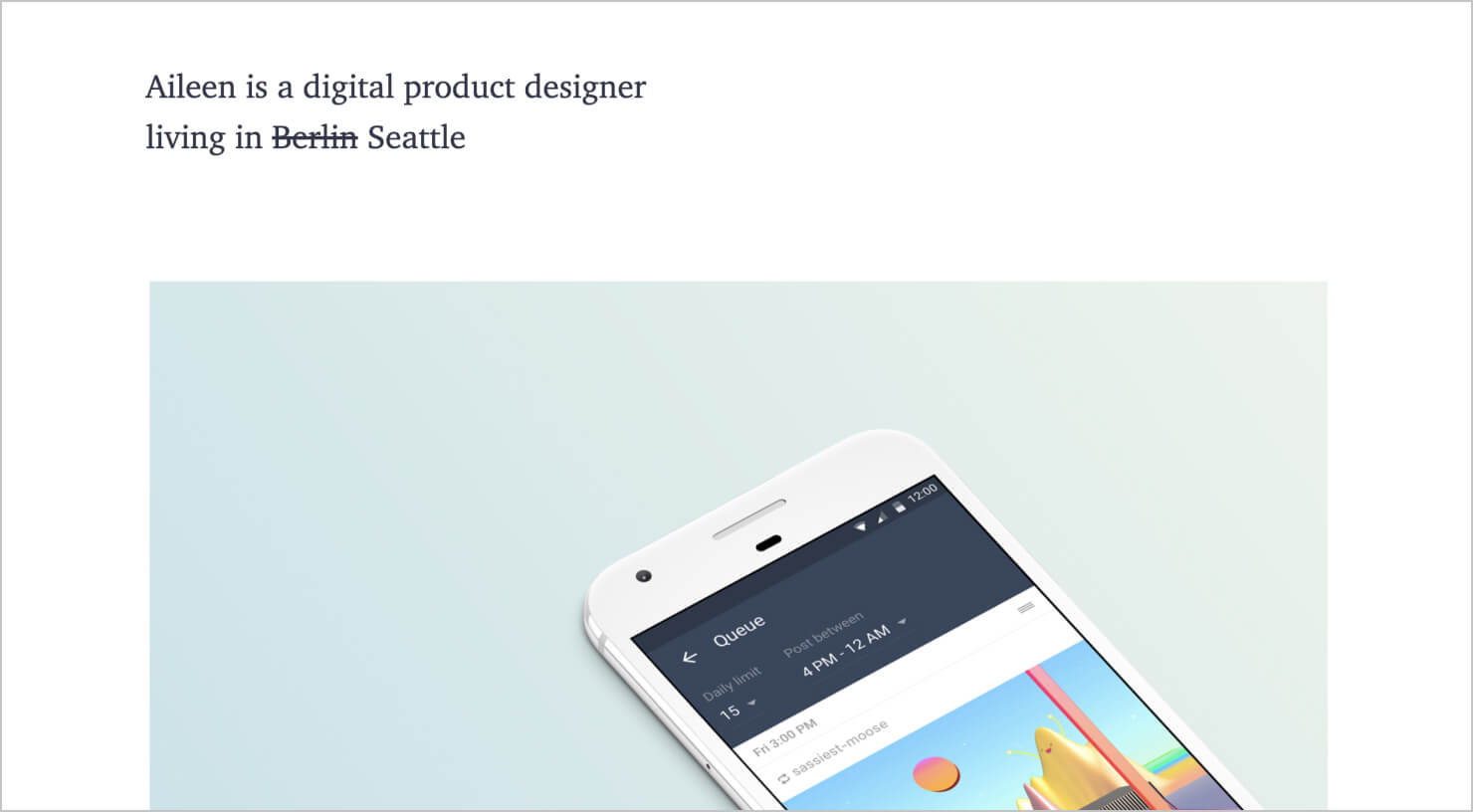Create a free portfolio website that stands out
Showcase your creativity with a free portfolio website. Get started with Webflow — build without writing code, plus everything you should include in your portfolio.
Browse a collection of unique portfolio website templates

Alex
$34 USD

Nero
$34 USD

Portfolio starter
Free

Uncommon
Free
What does a portfolio website do?
A portfolio gives your body of work its own space, in full color and on your terms. It also makes your projects instantly accessible. With a single link, people can see proof of your skill set. It’s more appealing than a static resumé, and turns interest into real work opportunities.
Communicates who you are
A portfolio brings your work and personality together in one place. Instead of just listing your skills, you can share the story behind each project and yourself. Tell potential clients how you think, how you solve problems, and what makes you different from everyone else in your field.
When people get to know the kind of person they’d be working with and see the work you do before hiring you, you know they’re contacting you because they think you’re a good fit.
Sells your work
Advertising your work is one thing, selling it is another. Webflow helps you do both.
Every portfolio template doubles as a digital storefront where you can add e-commerce functionality to sell artwork, templates, or products directly from your site. You can give people a single, trustworthy platform to support your work or commission your services.
What to include in your portfolio website
A strong portfolio shows what you’ve made and how you made it. To do this:
- Highlight the work that represents you best, focusing on quality over quantity.
- Put the projects you’re most proud of front and center, showing clients what you’re good at and the kind of work you want to attract.
- Make sure your contact details are easy to find, so anyone who wants to work with you can reach out.
- Test it on different devices to ensure it works well and consistently across desktop, mobile, and tablet screens to broaden your reach.
Depending on what you do, you might also:
- Add short case studies that explain your process, challenges, and results.
- Include mockups or prototypes to help people visualize your work.
- Display before-and-after comparisons.
With added context, good work turns into great storytelling, helping you stand out.
Unleash your creativity on the web
Build completely custom, production-ready websites — or ultra-high-fidelity prototypes — without writing a line of code.
How to make a portfolio website in 6 steps
1. Start from scratch or choose a template
Start building your website with a blank canvas or choose a portfolio template that fits your style. Templates give you a great foundation, so you can focus more on content. Plus, you still have complete creative freedom with every element.
2. Customize your portfolio
Make the site your own by changing colors, fonts, layouts, and animations. With Webflow’s visual design canvas, you’re not limited to presets. Every inch of the design is within your control, so you can choose a theme and build a page that truly reflects your personal style.

3. Share your personal brand
Add a dedicated page to tell your story and connect with new audiences, clients, and collaborators. This is your space to share a bit about yourself or your team, so people know who you are and not just the work you do. Give your site personality and visitors a reason to reach out.
4. Showcase the work you're proud of
Show off your best projects, the ones that reflect your skill, passion, and clientele. Use high-resolution visuals, short descriptions, and a thoughtfully created layout to walk people through your work. Whether you’re a freelancer or part of a small team, your portfolio should highlight the kinds of projects you want to do more of.
5. Publish your website
Go live in just a few clicks. With Webflow, you get reliable hosting, and you can connect your own custom domain. You don’t need any external plugins or complicated setups because everything happens in-house. Your site is fast, responsive, and ready to share instantly.
6. Keep your portfolio updated
An up-to-date portfolio tells potential clients that you’re active and ready to work. Revisit your site regularly to include new projects, refresh your layout, or add a big-name client. With Webflow, you don’t have to rely on developers to refresh your website.
Create an standout portfolio
With Webflow, you can bring your ideas to life exactly how you imagine them. Don’t just upload your work; design the entire user experience. Customize every detail, from layouts to animations, and create a portfolio site that feels as original as your projects. No rigid templates, no limits. It’s your creative playground.
Get started for free today.
FAQs
A portfolio website is a personal site that houses your best work, showcases your skills, and shares your creative identity. Whether you’re a graphic designer, product designer, web developer, writer, illustrator, web designer, or artist, it gives you a place to highlight past projects and make an impression online.
The best portfolio websites focus on a niche and are easy to navigate. This site should highlight your best work — not all your work — and give each project a spotlight, with a short explanation of your creative process, the tools used, and the results. It should also show your personality through thoughtful design choices or copywriting. And your portfolio site should have contact details that are easy to find, so anyone who wants to work with you can reach out. Lastly, it should work well and consistently across all devices to broaden your reach.
Yes. Webflow offers a free plan for designing, building, and publishing your portfolio, with or without writing code. Choose from thousands of portfolio templates or start from scratch. Either way, each Webflow site is fully customizable, giving you creative control over every element. Once you’re ready to go live, you can publish your site to a free domain. You can also upgrade at any time and connect a custom domain or unlock advanced features. It’s an intuitive way to start building your online presence, no matter your experience level. As you grow, so does your portfolio.
A CV, short for curriculum vitae, is a document that lists your work experience, education, skills, achievements, and contact information. CVs are typically text-heavy in bullet-point format and are submitted as college or job applications. On the other hand, a portfolio, especially a portfolio website, virtually showcases your actual work in detail. It includes case studies, images, mockups, and context about each project. A CV tells people what you’ve done, but a portfolio shows it, painting a complete picture of your abilities and past work.
Resources to learn more


How to implement Hotjar analytics on Webflow e-commerce sites


Build scalable client campaign workflows in Webflow with HubSpot integration


Build an event registration system with Webflow and Mailchimp
Get started for free
Try Webflow for as long as you like with our free Starter plan. Purchase a paid Site plan to publish, host, and unlock additional features.
Try Webflow for as long as you like with our free Starter plan. Purchase a paid Site plan to publish, host, and unlock additional features.





















